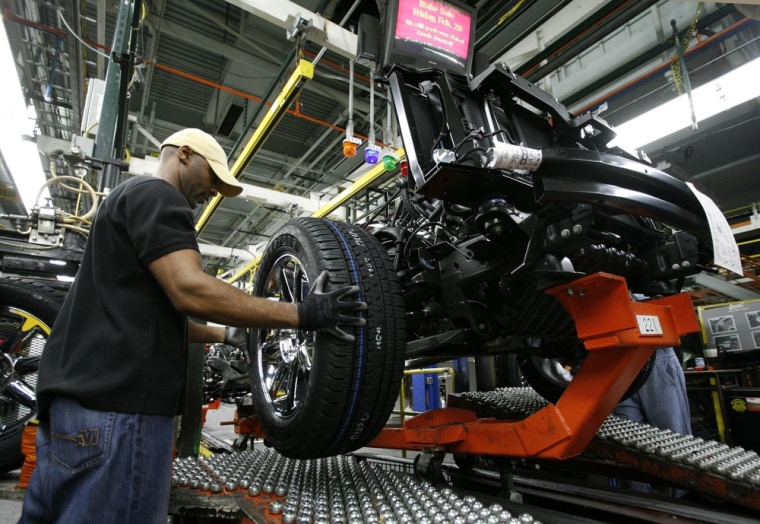Jobs — and not necessarily cash, or new benefits — have proved to be the centerpiece of the new four-year contract agreed between the United Auto Workers union and General Motors.
That’s not to say the deal doesn’t include some financial benefits designed to salve the frustrations of GM workers, who have made major concessions over the past four years to help revive the long-troubled automaker.
Among other things, the union has revealed, the new, four-year agreement includes a $5,000 signing bonus, $4,000 in “inflation protection” and another $3 an hour for second-tier employees earning half as much as veteran line workers.
But the agreement appears to have nonetheless held GM’s overall labor costs in check, industry analysts believe, and even offers the opportunity to improve productivity and lower costs still further at the automaker, helping the Detroit-based giant justify its plans to add more products — and more jobs — in the United States.
The union will now focus on selling the deal to Chrysler and Ford. If the UAW can succeed in that endeavor it could use the momentum it has gained in Detroit to help achieve another long-sought goal: unionizing European and Asian “transplant” assembly lines that have long resisted UAW organizers.
“The basis that we went into the agreement with was jobs, jobs, jobs, and I think that is what we came out of this agreement with,” UAW Vice President Joe Ashton said at a news conference revealing details of the GM deal.
Since emerging from bankruptcy with a $50 billion federal aid package two years ago, GM has added thousands of jobs in the U.S., and the new agreement could open up another 6,400 slots.
The automaker is promising to launch new products at plants in Spring Hill, Tenn., the former home of its now-abandoned Saturn division, as well as at factories in Michigan and Missouri.
Other key elements of the new GM contract include:
- A $5,000 signing bonus.
- A provision that could add another $4,000 in “inflation protection” over the next four years.
- A revised profit-sharing plan that will be based on all North American earnings, not just U.S. profits. That would have earned workers $5,000 last year, compared with the $4,300 they actually received.
- A $3-an-hour increase in Tier Two wages over the life of the four-year contract.
Despite those gains, the new contract “should not have a material impact on GM’s UAW labor cost structure,” according to Rod Lache, automotive analyst with Deutsche Bank. Provisions aimed at improving productivity, he said, “could produce fixed-cost reductions.”
That’s critical for GM — and for Ford and Chrysler, too. Just four years ago, the domestic automakers were paying an average of about $76 an hour in compensation for UAW workers, a full 50 percent more than what “transplant” carmakers paid at the Toyota assembly line in Georgetown, Ky., or the Honda East Liberty, Ohio, plant.
That higher payment averaged out to a cost penalty of more than $500 per vehicle — a significant disadvantage in the hotly competitive auto industry.
Labor costs began to come down when the UAW agreed to make major concessions in 2007 — and the union gave back even more when GM and Chrysler plunged into bankruptcy two years later.
As labor talks began in July it was believed the Detroit automakers were paying an average of just over $50 an hour — still several dollars higher than at the typical transplant automaker, and significantly higher than the newest foreign-owned factories, such as Volkswagen’s plant in Chattanooga, Tenn.
The UAW has struggled to organize workers in those transplant automakers’ plants since the first — a Honda facility in Marysville, Ohio — opened more than a quarter-century ago. Currently, only two transplants are represented by the UAW — the Mazda plant in Flat Rock, Mich., and the Mitsubishi line in Normal, Ill. — and that’s only because they were initially opened as joint ventures with one of the U.S. makers.
The challenge will be to overcome not only corporate resistance, but also worker reluctance at plants that are largely based in the mostly anti-union South, according to Harley Shaiken, a labor professor at the University of California in Berkeley.
The union hopes the relatively smooth deal with GM will be a selling point to workers at those foreign-owned factories, especially when the new signing bonus and other gains are added in.
The question is whether the new contract will be sellable to GM workers. Significantly, while the agreement ups pay for second-tier workers, it does not eliminate the unpopular two-tier pay structure.
GM’s 64,000 U.S. hourly workers will vote on the agreement over the next 10 days. Most observers believe that while noisy debate is likely, the agreement ultimately will be ratified. Union leaders Tuesday endorsed the agreement.
UAW bargainers are hoping to finish negotiations with Chrysler and Ford before the vote happens. The two companies are pressing for unique agreements, but the union is holding out — as it traditionally does — for so-called pattern agreements that don’t give an advantage to one automaker over another.
As with GM, the UAW is barred from striking Chrysler over financial issues as part of the 2009 federal bankruptcy bailout. Ford, the only carmaker not to receive a rescue package, could face a walkout, but that seems increasingly unlikely. The No. 2 domestic carmaker has generally had the best relationship with the UAW and it hasn’t seen its workers strike since the 1970s.
